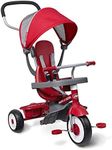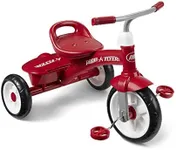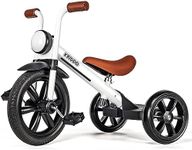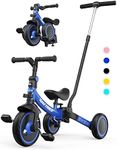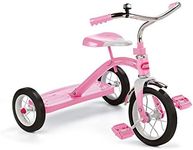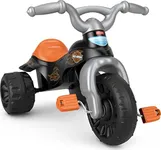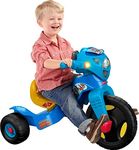Buying Guide for the Best Tricycle For 4 Year Old
Choosing a tricycle for a 4-year-old is an exciting step in helping your child develop balance, coordination, and confidence. At this age, children are eager to explore and enjoy a bit of independence, so it's important to find a tricycle that is safe, comfortable, and suitable for their size and abilities. When shopping, focus on features that match your child's needs and your environment, such as where the tricycle will be used (indoors, outdoors, on smooth or rough surfaces) and how much supervision your child will have. Understanding the key specifications will help you make a choice that keeps your child happy and safe.Size and Seat HeightThe size of the tricycle and the height of the seat are crucial because they determine whether your child can reach the pedals and touch the ground comfortably. Tricycles come in different sizes, and some have adjustable seats. For a 4-year-old, you want a tricycle where your child can sit with their feet flat on the ground and easily reach the pedals. If the seat is too high or too low, it can be uncomfortable and unsafe. Always check the manufacturer's recommended age and height range, and if possible, have your child try sitting on the tricycle before buying.
Wheel Type and SizeThe wheels affect how smoothly the tricycle rides and what surfaces it can handle. Plastic wheels are lightweight and good for indoor or smooth pavement, but they can be noisy and less durable outdoors. Rubber or foam wheels offer better grip and a smoother ride on sidewalks or rougher surfaces. Wheel size also matters: larger wheels roll more easily over bumps, while smaller wheels are lighter and easier for younger children to handle. Think about where your child will ride most often and choose wheels that match those conditions.
Frame MaterialThe frame material impacts the tricycle's weight, durability, and how easy it is to carry or move. Metal frames are sturdy and long-lasting, making them a good choice for outdoor use and active kids. Plastic frames are lighter and easier for a child to maneuver, but they may not be as durable for rough play. Consider how much the tricycle will be moved or transported, and whether you need something lightweight or more robust.
Safety FeaturesSafety features are essential for peace of mind. Look for tricycles with stable, wide wheelbases to prevent tipping, and check for features like handlebar grips, non-slip pedals, and rounded edges. Some tricycles have parent handles for extra control, which can be helpful if your child is still learning. Reflectors or bright colors can also make the tricycle more visible. Always prioritize safety features that match your child's skill level and your supervision style.
Adjustability and Growth PotentialAdjustable features, such as seats and handlebars, allow the tricycle to grow with your child, extending its usefulness. Some tricycles can convert into balance bikes or have removable pedals, offering more ways to use them as your child develops. If you want a tricycle that lasts more than a year, look for models with adjustable parts or multi-stage designs.
Ease of Use and ComfortA tricycle should be easy for your child to get on and off, and comfortable to ride. Look for low step-through frames, padded seats, and ergonomic handlebars. If your child will ride for longer periods, comfort becomes even more important. Test how easy it is for your child to steer and pedal, and make sure the tricycle feels stable and enjoyable for them.



